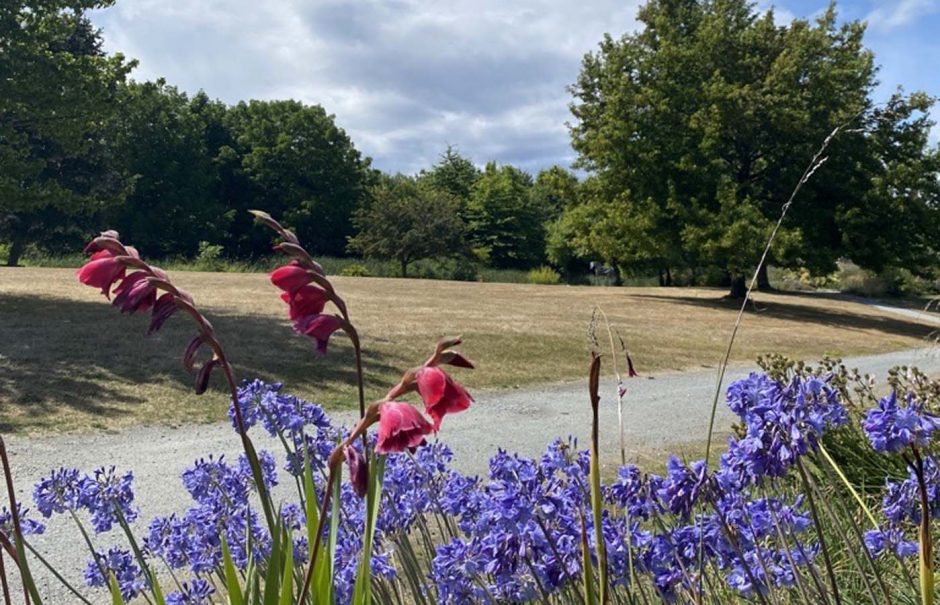
Here we are in another dry summer. Straw-coloured lawns greet us when we arrive at the Garden, and one doesn’t have to look very far beyond its boundaries to see crispy perennials and shrubs and stressed trees. People are quick to point to Metro Vancouver’s water restrictions, and certainly, the rules make it difficult to keep plants thriving in hot weather, but this is not the whole story. There’s no denying that prolonged drought can be hard on garden plants and that we don’t always make the connection between water conservation and weather—that is until we’re faced with serious water restrictions. And again, we have to admit that many established landscapes in Vancouver are absolutely dependent on summer irrigation. Vancouver’s soils, especially around UBC, are shallow and well-drained, and a good number of our garden plants—the majority of rhododendrons, for example—hail from parts of the world that experience considerable summer rainfall. In some years in Vancouver, summer rainfall is only an unexpected treat. The next time someone you know curses our winter “monsoon” be sure to remind them those rains fill our mountain lakes, which is the only thing that allows us to water our gardens in the summer.
Given that summers seem to be getting hotter, drier and longer (and the winters wetter), the resilience of many of our gardens will depend on a greater reliance on Mediterranean-climate-adapted plants. This is being reflected in a gradual shift in thinking among planners, landscape architects, gardeners and growers, and of course, botanical garden curators who are always a few steps ahead in considering what kinds of plants will thrive in the next decades. Nowhere in UBC Botanical Garden is this more evident than in the Garry Oak Meadow and Pacific Slope Gardens, where western North American plants are displayed. The burgeoning Pacific Slope collections in particular, which include plants from the drier parts of BC south into California, represent the Mediterranean climate in the extreme. As these gardens develop, they will be important for showcasing garden-worthy, drought-adapted trees, shrubs, perennials and annuals.
In the Botanical Garden, we’re fortunate to be able to continue to irrigate through the summer (and note that our efficient irrigation systems help to save water). Irrigation is necessary for establishing plants, but also, as already noted, for maintaining collections of plants with higher water needs. The scientific value of our collections is substantial and the cost of allowing many of our known-provenance plants (i.e., their collection localities are carefully documented) to languish is too great to ignore. Our so-called amenity collections (i.e., those plants without a specific scientific purpose), on the other hand, would appear to be harder to justify in times of water shortages, and plantings everywhere, including in the Botanical Garden, will continue to evolve to become more climate resilient. However, the cost to our mental well-being when beauty and biodiversity are diminished in our landscapes needs to be considered, as well. Water is valuable, but so are gardens, not least for the ecosystem services they provide. The car will survive a few months of not being washed. The driveway can be swept with a broom. I’ll consider showering less, optimizing dishwasher and laundry loading and I’ll definitely forego watering any lawns (the grass will recover with the onset of rain in the autumn, anyway), but we need gardens and our gardens need water.
Submitted by: Douglas Justice, Associate Director, Horticulture and Collections

Doug–
Thank you for your well composed and wise consul to northwest dwellers, gardeners included. The “natural” flora and fauna surrounding us dis the context in which our culture(in the widest sense of the word) evolves. If we value our culture there are actions we can take to create and sustain garden surrounds that respect our evolving ecosystem and actions we can take to reduce the humans practices that have negative impacts on our ecosystem.
Typo: should read “Excellent comment”
Except comment “ However, the cost to our mental well-being when beauty and biodiversity are diminished in our landscapes needs to be considered, as well”